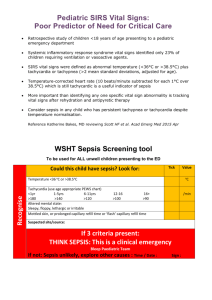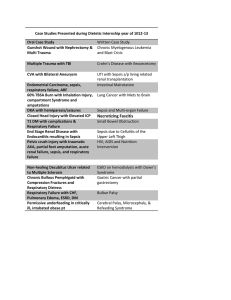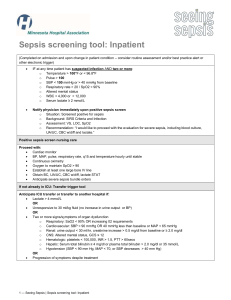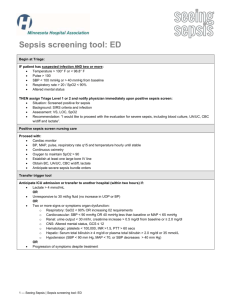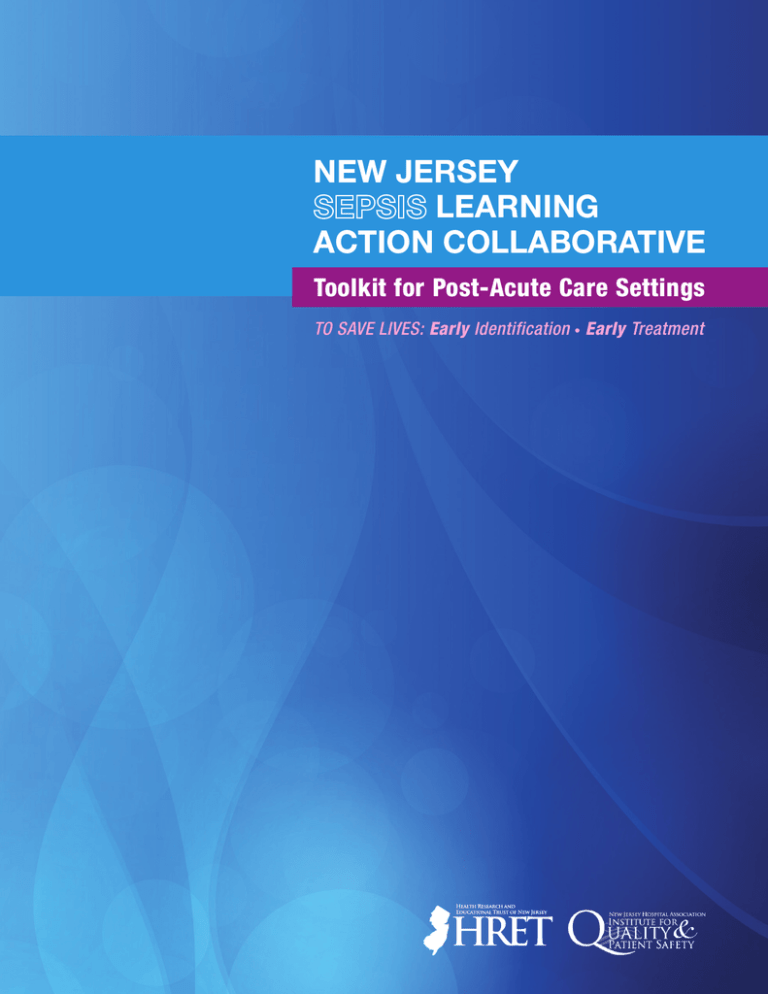
New Jersey
Learning
Action Collaborative
Toolkit for Post-Acute Care Settings
to save lives: Early Identification • Early Treatment
New Jersey
Learning
Action Collaborative
Toolkit for Post-Acute Care Settings
to save lives: Early Identification • Early Treatment
© 2015 Health Research and Educational Trust of New Jersey.
Published by the Health Research and Educational Trust of New Jersey, a non-profit
affiliate of the New Jersey Hospital Association, 760 Alexander Road, Princeton, NJ
08543-0001, www.njha.com.
All rights reserved. No part of this publication may be reproduced in any form without
prior written permission from the publisher. The publisher may not be held responsible
for any misprints, typographical and other errors, or any consequences caused as a
result of the use of this resource document.
TABLE OF CONTENTS
I. Overview
II. Instructions
III. Training Materials
a. Sepsis Educational Slides
IV. Sepsis Clinical Tools
a. Severe Sepsis Early Identification and Treatment Pathway
b. Severe Sepsis SBAR Communication Tool
V. Training Assessment
a. Sepsis Education Pre-Test
b. Sepsis Education Post-Test
c. Sepsis Training Evaluation Form
VI. Resource Page
OVERVIEW
T
his toolkit is a resource to assist healthcare organizations in implementing an early
severe sepsis identification and treatment program in the post-acute (facilitybased) healthcare setting. It is designed to provide post-acute healthcare
organizations with an evidence-based communication tool, staff education and care
pathway to assist in improving care processes to more quickly identify patients with
severe sepsis and to provide timely and effective treatment.
The New Jersey Hospital Association’s Institute for Quality and Patient Safety extends its
gratitude to collaborative faculty leaders, Dr. Phil Dellinger, MD, MCCM, and Christa
Schorr, RN, MSN, FCCM, of Cooper University Hospital and the Surviving Sepsis
Campaign, for their expertise and support in this endeavor to improve sepsis-related
care. Additionally, we acknowledge the following post-acute care organizations for their
commitment to working with us to design and implement this toolkit:
• Allendale Community for Senior Living, Allendale
• Bergen Regional Medical Center Long term Care, Paramus
• HealthSouth Rehabilitation Hospital of Tinton Falls
• HealthSouth Rehabilitation Hospital of Toms River
• Preakness Healthcare Center, Wayne
• St. Lawrence Rehabilitation Center, Lawrenceville
To learn more about the New Jersey Sepsis Learning Action Collaborative, please visit
www.NJHA.com/sepsis or contact Shannon Davila, RN, MSN, CIC, CPHQ, Clinical
Quality Improvement Manager, New Jersey Hospital Association, at sdavila@njha.com.
INSTRUCTIONS FOR USE OF THE TRAINING MATERIALS
(All referenced materials are included in this toolkit.)
T
o effectively educate and train healthcare staff within your facility on sepsis using
this toolkit, we suggest following these steps:
1. Identify the facility education and training coordinator within your facility who is
the primary contact and liaison with the NJ Sepsis Learning-Action Collaborative.
2. Print the following materials before accessing the education session Web link
(below). One copy of each per person:
a. Sepsis Education Pre-Test - to be completed by staff prior to viewing the
educational session
b. Sepsis Educational Slides - Definitions and Early Identification of Severe Sepsis
and Septic Shock presented by Dr. R. Phillip Dellinger, MD, MCCM and
Christa Schorr, RN, MSN, FCCM. Staff may use the handout to take notes and
refer to during the education session presentation.
c. Sepsis Education Post-Test - to be completed by staff after viewing the
education session
d. Sepsis Training Evaluation Form - to be completed by staff at the conclusion
of the training
3. Staff participating in this training should complete each form at the appropriate
time during the training. Pre- and Post-tests should be returned to the facility
education and training coordinator.
Click here to access the Sepsis Educational Session:
https://njha.webex.com/njha/lsr.php?RCID=20ed3615b3394c179afb11ce4f4acf59
As an additional step to properly identify and treat patients who present with sepsis and
to improve future sepsis education and trainings, the completed pre-tests, post-tests
and de-identifiable evaluation forms returned to the facility coordinator should be
forwarded to the New Jersey Sepsis Learning-Action Collaborative coordinator at
sdavila@njha.com.
NEW JERSEY SEPSIS LEARNING ACTION COLLABORATIVE
Toolkit for Post-Acute Care Settings
Definitions and Early Identification
of Severe Sepsis and Septic Shock
Education material for staff in long-term care,
rehabilitation facilities and short-term acute care
Christa Schorr, RN, MSN, FCCM
Associate Professor of Medicine
R. Phillip Dellinger, MD, MCCM
Professor of Medicine
Overview
Background
Definitions Signs & Symptoms
Treatment
2
1
NEW JERSEY SEPSIS LEARNING ACTION COLLABORATIVE
Toolkit for Post-Acute Care Settings
3
2
NEW JERSEY SEPSIS LEARNING ACTION COLLABORATIVE
Toolkit for Post-Acute Care Settings
Severe Sepsis
Severe Sepsis is the Leading Cause of Hospital
Death
Admissions with severe sepsis 8X > chance of
death than other conditions
Most expensive condition treated in the hospital
($23 billion per annum)
Enormous economic burden that can be
lessened with early identification and early
appropriate evidence based medicine care
5
NCHS data brief #62, 2011
US National Lib Med, NIH, 2010
HCUP Statistical Brief #160
5
3
NEW JERSEY SEPSIS LEARNING ACTION COLLABORATIVE
Toolkit for Post-Acute Care Settings
6
Older age and nursing home
residence were both
associated with a greater
likelihood of death and with
ICU admission.
4
NEW JERSEY SEPSIS LEARNING ACTION COLLABORATIVE
Toolkit for Post-Acute Care Settings
Which patients are at risk of sepsis?
Patients who have one
or more of the following:
Recent hospitalization
Indwelling catheters
Immobility
Wounds
Recent treatment for
an infection
Immunocompromised
7
What is sepsis, severe sepsis
and septic shock?
Definitions
Signs and symptoms
Treatment
8
5
NEW JERSEY SEPSIS LEARNING ACTION COLLABORATIVE
Toolkit for Post-Acute Care Settings
9
Definitions
Sepsis: presence (suspected or
confirmed) of infection with systemic
manifestations of infection
Severe Sepsis: Sepsis-induced tissue
hypoperfusion or organ dysfunction
Septic Shock: Hypotension that
persists despite adequate fluid
resuscitation
10
6
NEW JERSEY SEPSIS LEARNING ACTION COLLABORATIVE
Toolkit for Post-Acute Care Settings
Systemic Manifestations of Infection
Modified systemic inflammatory response
(SIRS) criteria
2 or more of the following:
Hyperthermia >38.3 C or 101.0 F
Hypothermia <36 C or 96.8 F
Altered mental status-(change from baseline)
Tachycardia >90 bpm
Tachypnea >20 bpm
Leukocytosis (WBC >12K)
Leukopenia (WBC <4K)
11
Organ Dysfunction
SBP <90 mmHg or MAP <65 mmHg
SBP decrease >40 mm Hg from baseline
Creatinine >2.0 mg/dl (176.8 mmol/L) or urine
12
output <0.5 ml/kg/hour for 2 hours
Bilirubin >2 mg/dl (34.2 mmol/L)
Platelet count <100,000 µL
Lactate >2 mmol/L (18.0 mg/dl)
Coagulopathy (INR >1.5 or aPTT >60 secs)
Acute lung injury with PaO2/FiO2 <250 in the
absence of pneumonia as infection source
Acute lung injury with PaO2/FiO2 <200 in the
presence of pneumonia as infection source
7
NEW JERSEY SEPSIS LEARNING ACTION COLLABORATIVE
Toolkit for Post-Acute Care Settings
The Importance of Early Detection
Efforts to just treat recognized sepsis alone is not
enough.
A critical aspect of mortality reduction has been
pushing practitioners to identify sepsis early.1
It may well be that earlier recognition accounts for
much of the signal in mortality reduction and partially
explains sharply increasing incidence.2
Without recognition that the clock is ticking, there is
simply no incentive to recognize a challenging
diagnosis early.
13
1. Levy MM, Dellinger RP, Townsend SR ,et al. Crit Care Med. 2010 Feb;38(2):367-74.
2. Gaieski DF, Edwards JM, Kallan MJ, et al. Crit Care Med. 2013 Feb 25.
Case Study & Treatment
14
8
NEW JERSEY SEPSIS LEARNING ACTION COLLABORATIVE
Toolkit for Post-Acute Care Settings
Applying the Definitions: Case
67 yo man who was admitted for an acute
stroke, with left sided hemiplegia.
On rehabilitation day 5 his vital signs are: T
102.4, HR 112, R 24, BP 98/55, SpO2 94% on
room air. He is coughing and has right lower
lobe crackles on exam.
What additional information do you need to
determine if this is sepsis, severe sepsis, or
septic shock?
15
Applying the Definitions: Case
Labs:
WBC 16,000 with 15% bands
Creatinine 2.4 mg/dl (normal on admission)
Lactate 3.5 mmol/L
Repeat vital signs:
BP 88/53, HR 118, R 22, SpO2 98%
Is this sepsis, severe sepsis or septic
16
shock?
Do you need more information to make
that determination?
9
NEW JERSEY SEPSIS LEARNING ACTION COLLABORATIVE
Toolkit for Post-Acute Care Settings
What should you expect to do next?
Notify the physician of your assessment
findings and laboratory results
Use SBAR to facilitate understanding and
clarify next steps
SBAR (situation, background, assessment and
recommendation)
Plan for close monitoring
Increase vitals signs
Additional labs
Initiation of the sepsis bundles
17
Consider transfer to an acute care facility
SSC BUNDLE
TO BE COMPLETED WITHIN 3 HOURS OF
TIME OF PRESENTATION:
1. Measure lactate level
2. Obtain blood cultures prior to administration of
antibiotics
3. Administer broad spectrum antibiotics
4. Administer 30 ml/kg crystalloid for hypotension
or lactate ≥4 mmol/L
20
10
NEW JERSEY SEPSIS LEARNING ACTION COLLABORATIVE
Toolkit for Post-Acute Care Settings
SSC BUNDLE
TO BE COMPLETED WITHIN 6 HOURS OF
TIME OF PRESENTATION:
5. Apply vasopressors (for hypotension that
does not respond to initial fluid resuscitation
to maintain a mean arterial pressure (MAP)
≥65 mmHg)
6. In the event of persistent arterial hypotension
despite volume resuscitation (septic shock) or
initial lactate ≥4 mmol/L (36 mg/dl):
- Reassess volume and tissue perfusion
7. Remeasure lactate if initial lactate was
21
elevated. (>2 mmol/L)
To Save Lives.....
Early identification
Early antibiotics
20
Early (aggressive) fluid resuscitation
11
NEW JERSEY SEPSIS LEARNING ACTION COLLABORATIVE
Toolkit for Post-Acute Care Settings
21
12
SEPSIS EARLY IDENTIFICATION AND TREATMENT PATHWAY
Assess for Infection and SIRS
Does the patient have a possible or active
infection?
Symptoms or signs of infection can include:
• Fever/chills
• Cough/shortness of breath
• Cellulitis/wound drainage
• Changes in urine (volume, painful urination, color,
odor)
Does the patient have 2 or more of the SIRS criteria?
(SIRS= Systemic Inflammatory Response Syndrome)
SIRS Criteria include:
• Hyperthermia >38.3 C or >101.0 F
• Hypothermia <36 C or <96.8 F
• Change in mental status
• Tachycardia >90 bpm
• Tachypnea >20 bpm
• Leukocytosis (WBC >12K)
• Leukopenia (WBC <4K)
Yes to both? Think SEPSIS!
Prepare to contact medical provider:
Contact the medical provider
• Review the record for medications, allergies,
recent infections or antibiotic use
• Note the patient’s advance directive or care
wishes (if comfort care, suggested
interventions below)
• Complete sepsis SBAR
Comfort Care Interventions:
•
•
•
•
•
Pain control
Medications to lower fever
Frequent repositioning
Frequent oral care
Offer fluids (if tolerated)
Prepare for these possible interventions to be completed
as soon as possible:
•
•
•
•
Transfer to higher level of care
Draw Labs: Lactate, CBC w/ diff, blood cultures
Establish IV access
Administer broad spectrum intravenous antibiotics
For hypotension SBP less than 90 mmHg or lactate
greater than 4:
• Administer IV fluid bolus at 30 ml/kg
Monitor the patient and notify the
medical provider of any worsening or
progression of sepsis.
SBAR FOR SEPSIS
S
(describe the
situation)
B
(provide
background)
• My name is _________and I am calling from _____________.
• I need to speak to you about patient Mr. or Mrs.
_______________________.
• This patient is showing signs and symptoms of infection and
sepsis.
• The patient was admitted on ___________ (date) with the
diagnosis of_________________ (original condition).
• The patient now is showing these signs of a possible infection
______________ (describe the signs and potential source of
infection).
• This started on ______________ (date).
• The patient is allergic to___________.
• The patient's advance care directive is_________________.
• My assessment of the situation is that the patient may be
experiencing a new or worsening of his/her infection. Here are
my assessment findings:
A
(describe the
key assessment
findings)
• The current vital signs:
• BP __________ HR ________ RR ___________
• Temp __________ SPO2 _______________ (on room air or
supplemental O2)
• The patient has voided __________ times in the last 8 hours
• Mental status is (changed or unchanged) from baseline
___________
• Other physical assessment findings that are related to possible
infection or sepsis (lung sounds, wound assessments, etc):
___________________________________
R
(recommendation)
• I am concerned this patient has sepsis. I recommend that you
see the patient as soon as possible and that we order a serum
lactate, blood cultures and a basic metabolic panel. Do you
agree?
• If the patient is hypotensive: Should I start an IV and give a fluid
bolus?
• The physician should confirm, clarify and request additional
information and then work with the nurse to take appropriate
action with this patient.
Before Calling the
Physician / NP /
PA/other Healthcare
Professional:
Evaluate the patient and
complete this form
Check vital signs- be alert
for the early sepsis
warning signs
Review the patient
record: recent
hospitalization, lab values,
medications, and progress
notes
Note any allergies
Be aware of the patient’s
advance care wishes
Early Sepsis Warning
Signs
Report any of these
Findings:
Temp >38.3 C (101.0 F)
Temp <36.0 C (96.8 F)
Heart rate >90 bpm
Respiratory rate >20 bpm
White Blood Cell Count
>12,000 µL-1 or
<4,000 µL-1
Altered mental status
SPO2 <90%
Decreased urine output
From recently drawn labs
(within 24 hours):
Creatinine >2.0 mg/dl
(176.8 mmol/L)
Bilirubin >2 mg/dl
(34.2 mmol/L)
Platelet count <100,000
µL
Lactate >2 mmol/L
(18.0 mg/dl)
Coagulopathy (INR >1.5 or
aPTT >60 secs)
SEPSIS EDUCATION PRE-TEST
(Learners should complete this test prior to viewing the sepsis
presentation)
Name: _____________________________________
Facility: ____________________________________
Date: ______________________________________
1. Why is early detection of sepsis so important? __________________________________________________
2. Which of the following patients is at high risk of developing sepsis?
a)
b)
c)
d)
Heart failure patient
Patient with dementia
Patient recently hospitalized with severe urinary tract infection
Patient recovering from a heart attack
3. Who should you notify if you suspect a patient has sepsis? ________________________________________
4. What does SIRS stand for? ___________________________________________________________________
5. List three SIRs symptoms:
1. _______________________
2. _________________________
3. ___________________________
6. What are the four stages of sepsis disease?
1. ______________________________________ 3. _______________________________________
2. ______________________________________ 4. _______________________________________
7. Blood cultures should be collected before the first dose of intravenous antibiotics are administered.
True or False
8. What labs should be drawn when a patient has sepsis?
a)
b)
c)
d)
Lactate
Complete blood count
Blood cultures
All of the above
9. Which of the following labs would indicate a patient with sepsis has worsened to severe sepsis?
a)
b)
c)
d)
Lactate 2.4 mmol/L
Creatinine 3.0 mg/dl
Platelet 80,000 uL
All of the above
10. What is the volume of fluid that should be bolused to a hypotensive septic shock patient? _____________
SEPSIS EDUCATION POST-TEST
(Learners should complete this test and the training evaluation after
viewing the sepsis presentation)
Name: _____________________________________
Facility: ____________________________________
Date: ______________________________________
1. Which of the following patients is at high risk of developing sepsis?
a)
b)
c)
d)
Heart failure patient
Patient with dementia
Patient recently hospitalized with severe urinary tract infection
Patient recovering from a heart attack
2. What are the four stages of sepsis disease?
1. ______________________________________ 3. _______________________________________
2. ______________________________________ 4. _______________________________________
3. What does SIRS stand for? ___________________________________________________________________
4. List three SIRs symptoms:
1. _______________________
2. _________________________
3. ___________________________
5. Why is early detection of sepsis so important? __________________________________________________
6. Who should you notify if you suspect a patient has sepsis? ________________________________________
7. What labs should be drawn when a patient has sepsis?
a)
b)
c)
d)
Lactate
Complete blood count
Blood cultures
All of the above
8. Which of the following labs would indicate a patient with sepsis has worsened to severe sepsis?
a)
b)
c)
d)
Lactate 2.4 mmol/L
Creatinine 3.0 mg/dl
Platelet 80,000 uL
All of the above
9. Blood cultures should be collected before the first dose of intravenous antibiotics are administered.
True or False
10. What is the volume of fluid that should be bolused to a hypotensive septic shock patient? _____________
SEPSIS EDUCATION TRAINING EVALUATION
Please rate your level of agreement with the following statements:
Strongly
Disagree
Disagree
Neutral
Agree
Strongly
Agree
The slide presentation was well organized.
Watching this presentation was an effective use of my time.
This training will help my organization improve sepsis identification.
I will be able to immediately use what I learned.
I am confident that I can perform the assessments and tasks that
were trained.
Please rate your level of confidence in the following before this activity and after using the scale
(1=“Very Low”; 2=“Low”; 3=“Neutral”; 4=“High”; 5=“Very High”):
Before Training
After Training
My understanding of the criteria to define sepsis and severe sepsis.
1
2
3
4
5
1
2
3
4
5
My understanding of factors that place certain patients at high risk for
developing severe sepsis.
1
2
3
4
5
1
2
3
4
5
My knowledge of sepsis symptoms, SIRS, and organ dysfunction
criteria.
1
2
3
4
5
1
2
3
4
5
My understanding of the 3-hour bundle treatments.
1
2
3
4
5
1
2
3
4
5
What could make this training more effective?
___________________________________________________________________________________
___________________________________________________________________________________
___________________________________________________________________________________
Comments:
___________________________________________________________________________________
___________________________________________________________________________________
___________________________________________________________________________________
RESOURCES
New Jersey Sepsis Learning-Action Collaborative
www.njha.com/sepsis
Surviving Sepsis Campaign
http://www.survivingsepsis.org/Pages/default.aspx
Centers for Disease Control and Prevention - Sepsis
http://www.cdc.gov/sepsis/index.html
Centers for Disease Control and Prevention - Nursing Homes and Assisted Living
Resources
http://www.cdc.gov/longtermcare/
Minnesota Hospital Association “Seeing Sepsis Long Term Care Resources”
http://www.mnhospitals.org/patient-safety/current-safety-quality-initiatives/severesepsis-and-septic-shock
American Hospital Association’s Health Research and Educational Trust
“Sepsis Resources”
http://www.hrethen.org/index.php?option=com_phocadownload&view=category&id=370&Itemid=369
EVIDENCE-BASED LITERATURE RESOURCES
Goodwin, A.J., Rice, D. A., Simpson, K. N. & Ford, D. W. “Frequency, cost, and risk
factors of readmissions among severe sepsis survivors.” Critical Care Medicine. No. 43,
Issue 4. (April 2015): 738-46. http://www.ncbi.nlm.nih.gov/pubmed/25746745
Otego, A. et al. “Hospital-based acute care use in survivors of septic shock.” Critical Care
Medicine. No. 43, Issue 4. (April 2015): 729-37.
http://www.ncbi.nlm.nih.gov/pubmed/25365724
760 Alexander Road, Princeton, NJ 08540
www.njha.com



